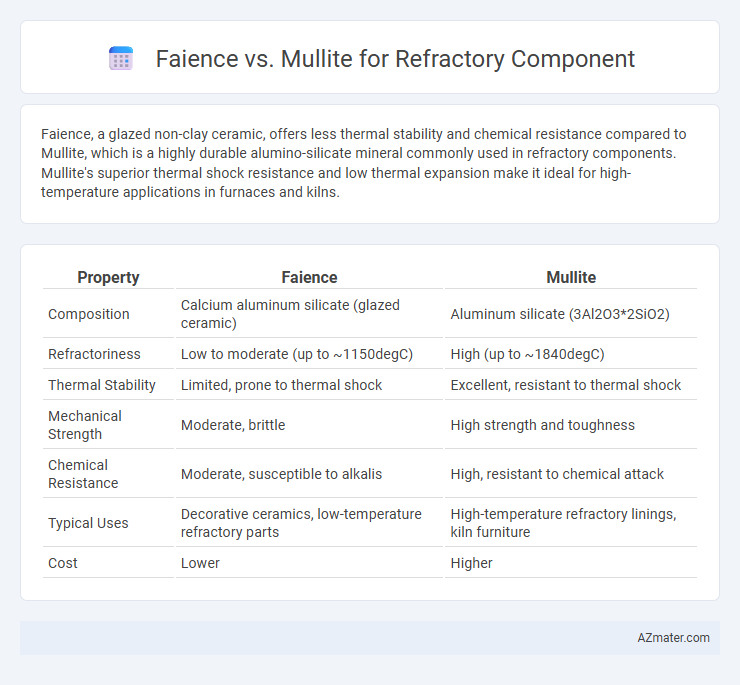Faience, a glazed non-clay ceramic, offers less thermal stability and chemical resistance compared to Mullite, which is a highly durable alumino-silicate mineral commonly used in refractory components. Mullite's superior thermal shock resistance and low thermal expansion make it ideal for high-temperature applications in furnaces and kilns.
Table of Comparison
| Property | Faience | Mullite |
|---|---|---|
| Composition | Calcium aluminum silicate (glazed ceramic) | Aluminum silicate (3Al2O3*2SiO2) |
| Refractoriness | Low to moderate (up to ~1150degC) | High (up to ~1840degC) |
| Thermal Stability | Limited, prone to thermal shock | Excellent, resistant to thermal shock |
| Mechanical Strength | Moderate, brittle | High strength and toughness |
| Chemical Resistance | Moderate, susceptible to alkalis | High, resistant to chemical attack |
| Typical Uses | Decorative ceramics, low-temperature refractory parts | High-temperature refractory linings, kiln furniture |
| Cost | Lower | Higher |
Introduction to Refractory Components
Refractory components are essential materials designed to withstand high temperatures and harsh environments in industrial applications such as furnaces, kilns, and reactors. Faience, a glazed ceramic material primarily composed of silica and alkalis, offers moderate thermal resistance but lacks the robustness of advanced refractory materials. Mullite, an alumino-silicate ceramic with exceptional thermal stability, mechanical strength, and low thermal expansion, is preferred for high-performance refractory components where durability and heat resistance are critical.
What is Faience?
Faience is a glazed ceramic material composed primarily of finely ground quartz or sand, combined with clay and other additives, known for its decorative and functional applications. Its low thermal shock resistance and melting point make it less suitable for high-temperature refractory components compared to mullite. Mullite, an alumino-silicate mineral with excellent thermal stability, is preferred in refractory materials due to its superior resistance to heat and mechanical strength.
What is Mullite?
Mullite is a highly refractory aluminosilicate mineral composed primarily of 3Al2O3*2SiO2, known for its exceptional thermal stability, low thermal expansion, and excellent resistance to chemical corrosion in high-temperature environments. Commonly used in refractory components, mullite enhances structural integrity and thermal shock resistance in kiln linings, furnace bricks, and ceramic substrates. Its superior mechanical strength and oxidation resistance outperform faience, making it a preferred material for industrial applications requiring durable and heat-resistant refractories.
Physical Properties: Faience vs Mullite
Faience exhibits moderate thermal expansion and lower mechanical strength, making it less durable under high-temperature conditions compared to mullite. Mullite demonstrates exceptional thermal stability, high melting point (approximately 1840degC), and superior mechanical strength, providing enhanced resistance to thermal shock and cracking. These physical properties position mullite as a more reliable choice for refractory components subjected to extreme heat and mechanical stress.
Thermal Resistance Comparison
Faience exhibits moderate thermal resistance suitable for low to medium temperature applications, withstanding temperatures up to approximately 1200degC. Mullite significantly outperforms faience in thermal resistance, maintaining structural integrity at temperatures exceeding 1700degC, making it ideal for high-temperature refractory components. The superior thermal stability of mullite results from its crystalline structure and low thermal expansion coefficient, providing enhanced durability in harsh thermal environments.
Chemical Durability and Corrosion Resistance
Faience exhibits moderate chemical durability but is prone to corrosion under high-temperature and aggressive environments, limiting its use in refractory components exposed to slag or molten metals. Mullite offers superior chemical durability and excellent corrosion resistance due to its stable alumino-silicate structure, making it ideal for high-temperature refractory applications. The crystalline nature of mullite enhances its resistance to chemical attack, outperforming the more porous, glassy faience material.
Mechanical Strength and Wear Performance
Faience exhibits moderate mechanical strength and wear resistance, making it suitable for low to medium temperature refractory applications but less ideal for high-stress environments. Mullite offers superior mechanical strength and excellent wear performance due to its stable aluminosilicate structure, allowing it to withstand severe thermal and mechanical stresses in industrial refractory components. The enhanced durability and resistance to abrasion in mullite significantly extend service life compared to faience in demanding refractory applications.
Applications in Industry: Faience vs Mullite
Faience, a glazed non-clay ceramic, excels in decorative and low-temperature refractory applications due to its aesthetic appeal and moderate thermal resistance. Mullite, an aluminosilicate mineral, offers superior thermal stability, chemical resistance, and mechanical strength, making it ideal for high-temperature industrial applications such as kiln linings, furnace components, and thermal insulation. Industries requiring durability under extreme heat, including metallurgy, ceramics manufacturing, and glass production, predominantly utilize mullite over faience for refractory components.
Cost-Effectiveness and Availability
Faience offers lower raw material costs and easy local availability, making it a cost-effective choice for refractory components in less demanding applications. Mullite provides superior thermal stability and mechanical strength, justifying its higher price in high-performance refractory uses despite less widespread availability. Choosing between faience and mullite depends on balancing budget constraints with the required durability and operating conditions of the refractory system.
Choosing the Right Material for Refractory Needs
Faience, known for its glazed ceramic surface, offers moderate thermal resistance and aesthetic appeal but lacks the high-temperature durability required for severe refractory applications. Mullite, an aluminosilicate ceramic with excellent thermal shock resistance and stability up to 1800degC, is ideal for demanding refractory components exposed to extreme heat. Selecting mullite over faience ensures enhanced structural integrity and longevity in high-temperature industrial environments such as kilns and furnaces.

Infographic: Faience vs Mullite for Refractory Component
 azmater.com
azmater.com